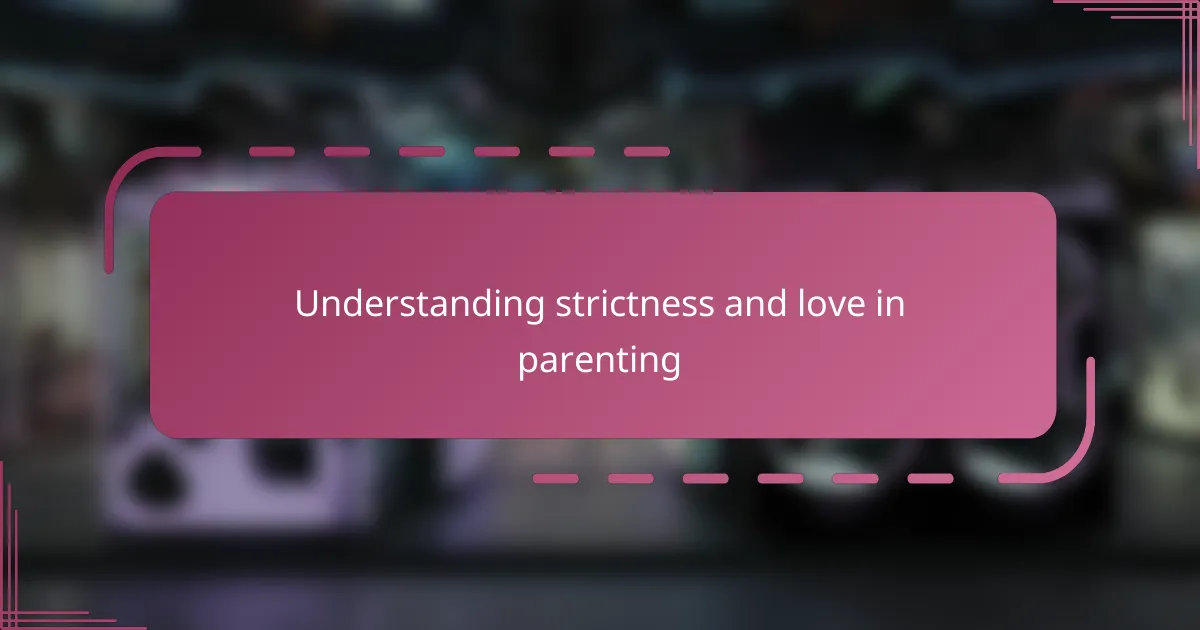Key takeaways
- Strictness in parenting is about setting clear boundaries with love that fosters safety and guidance rather than punishment.
- Balancing discipline and affection builds trust, making children feel cared for rather than controlled.
- Empathy in enforcing rules helps children understand boundaries as partnerships, enhancing connection and reducing conflict.
- Consistency in discipline, paired with open communication and involvement in decision-making, cultivates respect and a secure environment for children.

Understanding strictness and love in parenting
Strictness in parenting isn’t about being harsh; it’s about setting clear boundaries that help children feel safe. When I first realized this, it changed how I approached discipline—I saw that firmness could coexist with warmth. Have you ever noticed how kids actually crave those consistent rules more than unlimited freedom?
Love, in my experience, is the foundation that supports strictness. Without love, rules feel like punishments rather than guidance. I often remind myself that every “no” I say carries the message, “I care about you enough to help you make the right choices.”
Balancing these two wasn’t easy at first. I used to worry that being strict might push my child away, but I found the opposite: love makes the rules softer, and rules give love a clear direction. Isn’t parenting about finding that delicate dance between heart and hand?

Importance of balancing discipline and affection
Finding the right balance between discipline and affection has been essential in building trust with my child. When I’m firm but loving, my child doesn’t feel controlled—they feel cared for. Have you ever noticed how a gentle tone paired with a clear rule makes lessons stick better than shouting ever could?
I’ve learned that without affection, discipline can come across as cold or punitive, which shuts down communication. But when love is present, even the toughest boundaries become invitations to grow rather than walls to resent. It’s like planting seeds with care; discipline waters them, and love makes them bloom.
At times, I struggled to keep this balance—too strict, and I saw withdrawal; too lenient, and I faced chaos. Now, I cherish moments when my child responds with understanding because they feel both guided and supported. Isn’t that what every parent ultimately hopes for?

Setting clear boundaries with empathy
Setting clear boundaries with empathy has been a game-changer in my parenting journey. Instead of just saying “no” outright, I take a moment to explain why a boundary exists, showing my child that my decisions come from care, not control. Have you ever noticed how kids respond better when they feel understood rather than simply restricted?
There were times when I worried that enforcing limits might seem harsh, but I realized that empathizing with my child’s feelings softens even the firmest rules. For example, saying, “I know you want to keep playing, but bedtime helps you stay healthy,” makes the boundary feel like a partnership, not a punishment. This approach has deepened our connection and made discipline less of a battle.
Sometimes, it’s challenging to balance empathy with authority, especially when emotions run high. Yet, I’ve found that pausing to acknowledge my child’s frustration before restating the boundary helps both of us stay calm. Isn’t it amazing how empathy can make rules feel less like barriers and more like bridges?

Communicating effectively with children
When I talk with my child, I make sure to listen more than I speak. It’s surprising how much children reveal when they feel heard; they open up about their fears and hopes, and that helps me guide them better. Have you ever noticed how a simple question like “How do you feel about this?” can turn a moment of tension into a meaningful conversation?
I’ve also learned that clarity is key. When explaining expectations, I keep my language simple and specific. Saying, “You need to finish your homework before screen time,” rather than a vague “Be responsible,” reduces confusion and helps my child understand exactly what’s expected.
Sometimes, emotions run high, and words don’t come easily. In those moments, I take a deep breath and lower my voice instead of raising it. Showing calmness teaches my child to mirror that calm, turning potential conflicts into opportunities for connection. Isn’t it incredible how much tone affects communication?

Practical activities to build trust and respect
One activity I found especially effective is setting aside “trust time” each week—just fifteen minutes where my child and I put away distractions and talk openly about anything on their mind. These moments didn’t just build trust; they showed my child that I value their thoughts and feelings, making it easier for them to respect the boundaries I set. Have you ever tried carving out time like this? The difference it makes can be surprising.
Another practical way I build respect is by involving my child in decision-making when appropriate. Whether it’s choosing a family activity or setting certain house rules together, this collaborative approach reinforces their sense of responsibility and shows that their opinion matters. When children feel heard, don’t they naturally want to honor agreements made with their parents?
Finally, I rely heavily on consistent routines and follow-through. When I keep promises and hold to agreed-upon consequences, my child learns that trust isn’t just a word—it’s an action observed daily. This consistency creates a safe environment where respect grows because everyone knows what to expect. Have you noticed how children respond when rules are reliable and fair? I sure have, and it’s been a cornerstone of our relationship.

Personal experience in balancing parenting styles
Finding the middle ground between strictness and love was a journey filled with trial and error for me. I remember times when I clung too tightly to rules, thinking that toughness was the key to good parenting, only to see my child retreat emotionally. Have you ever felt that tension between wanting to be firm and still wanting to be your child’s safe place? That struggle pushed me to soften my approach without letting go of the boundaries.
One moment that stands out was when my child broke curfew. Instead of reacting harshly, I chose to sit down and listen to their side first. The conversation that followed wasn’t just about the rule itself; it was about trust and understanding. From then on, I realized that strictness paired with empathy wasn’t just possible—it was necessary for our relationship to thrive. Doesn’t it feel more powerful when a child respects a rule because they understand it, not just because they fear punishment?
Balancing these styles hasn’t been perfect, and some days feel tougher than others. But I’ve learned that showing love openly while holding firm doesn’t confuse kids—it teaches them respect and security. Isn’t that what every parent hopes for—a child who knows they are loved and guided at the same time?

Tips for consistent and loving discipline
Consistency has been my compass in the sometimes stormy sea of discipline. When I stay steady with rules, my child knows what to expect and feels safer, even when the lesson is tough. Have you noticed how kids test boundaries more when rules shift? Keeping a consistent approach helps avoid confusion and builds trust that I’m truly there to support—not just to correct.
Showing love alongside discipline means blending firmness with kindness. I’ve found that praising my child’s good choices immediately after enforcing a rule softens the experience for both of us. For instance, saying, “I’m proud you stopped playing when I asked,” turns discipline into encouragement rather than criticism. Doesn’t positive recognition make the rules feel less like obstacles and more like guidance?
Sometimes, the hardest part is following through without losing heart. There were moments I felt tempted to bend or forget consequences, thinking it would ease tensions. But I learned that showing both commitment and warmth helped my child respect the boundaries even more. Have you experienced that moment when steady love makes discipline feel less like a battle and more like a shared journey? That’s where the magic happens.


